#from caligari to hitler
Explore tagged Tumblr posts
Text

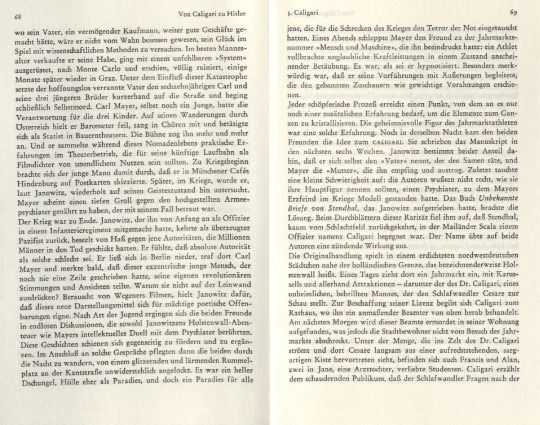
von caligari zu hitler - eine psychologische geschichte des deutschen films, siegfried kracauer, princeton university press 1947, suhrkamp 1979: der schock der freiheit/ caligari s. 49 - 83
*


roman polanski: wanted and desired, marina zenovich 2008
#siegfried kracauer#from caligari to hitler#a psychological history of the german film#princeton university press#1947#suhrkamp#1979#der schock der freiheit#caligari#richard oswald#das cabinet des dr. caligari#m#roman polanski: wanted and desired#marina zenovich#lenny#jfk#books
2 notes
·
View notes
Text
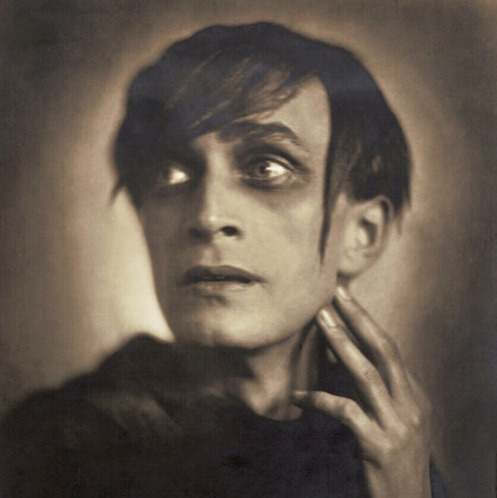
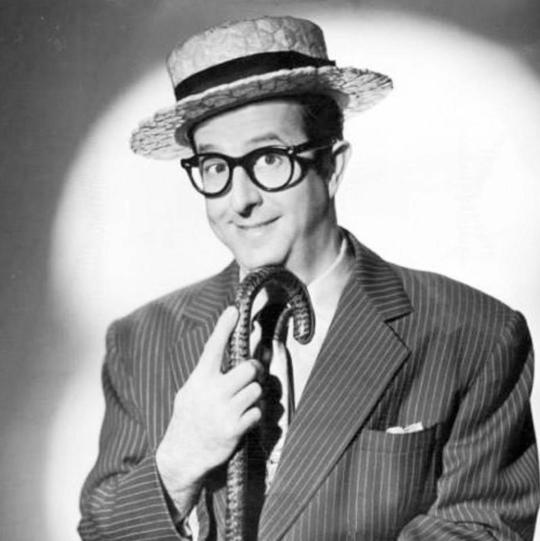
Conrad Veidt (The Cabinet of Dr Caligari, The Man Who Laughs)— oh my god look at him in Caligari. I specifically said that he's from this because him as Cesare is just. MMMMM. he's so wet and sad and scrungly. and little. he's like a kitten left alone in a dark alley except he's also killed people (not his fault). something wrong with him (Cesare). as for Conrad himself. oh my god look at him... them big ole eyes and the walk of some fucking thing creature
Phil Silvers (Summer Stock)—this man has the single most expressive face in all of golden age hollywood (okay maybe second only to Donald O'Connor) and he is such a Perfect counterpart to Gene Kelly in Summer Stock. like, little baby queer lady me had such a soft spot for the funky little comic relief guys and he's the king of them all! his verse in "Dig For Your Dinner" [link] makes me laugh uncontrollably and every time i watch it, my brain plays "YOU GOTTA SEE YOUR DENTIST TWICE A YEAR" on loop for a solid week afterwards
This is round 1 of the contest. All other polls in this bracket can be found here. If you're confused on what a scrungle is, or any of the rules of the contest, click here.
[additional submitted propaganda + scrungly videos under the cut]
Conrad Veidt:
youtube
I mean just look at him. The wet cat energy. The ghostly eyes. He did the monster mash before anybody. Where would we be today without him, he even has one (1) song on spotify. I regularly forget he's dead and wonder what his next movie will be. He slays in any role. The Ultimate Skrunkle.
He's the ultimate scrungly to me, the basis for many of our scrungly guys today. he's so skinny and pale and he wears so much eye makeup
He was THE bisexual goth tumblr sexyman of early film. Seriously the old timey Tumblrinas would send him fanmail about wanting him to choke them. He inspired the designs for the Joker and Jafar,and was nicknamed the “Demon of the Silver Screen” for his horror roles. His first wife divorced him for crossdressing. Hitler sent him hate mail for speaking out about antisemitism. He really loved his wife and told the Germans to go fuck themselves when they threatened his job if he didn’t divorce her for being Jewish. Just look at me and tell me this guy isn’t scrungly he’s like a personification of the emo kid from Horton hears a who
[cw the below clip depicts assault/abduction and could be scary for some viewers]
youtube
Phil Silvers:
"it's hard to hold the screen against don knotts, but phil manages."
youtube
90 notes
·
View notes
Text


The manner in which certain identities and subjectivities perform within narratives help to reproduce and reassert the rewards of being a good citizen whilst concomitantly projecting the perils of being ideologically-subversive. Marxist sociologist Siegfried Kracauer engaged with some of these issues as early as 1947 within his seminal work From Caligari to Hitler: A Psychological History of German Film. Here, Kracauer argued that early Weimar cinema and its characte constructions not only served to reflect the contemporary culture which produced them, but also served to unearth certain underlying truths that were not immediately obvious (in this case, anticipating Germany’s embrace of fascism). Kracauer depicted film and its images as a form of cultural mirror that could be studied to better understand the world and culture that produced them.
#cinema#studies#filmaking#sociology#interview with the vampire#film review#lestat de lioncourt#claudia#louis de pointe du lac
17 notes
·
View notes
Text

Conrad Veidt and Werner Krauss in The Cabinet of Dr. Caligari (Robert Wiene, 1920)
Cast: Werner Krauss, Conrad Veidt, Friedrich Feher, Lil Dagover, Hans Heinrich von Twardowski, Rudolf Lettinger. Screenplay: Carl Mayer, Hans Janowitz. Cinematography: Willy Hameister. Production design: Walter Reimann, Walter Röhrig, Herrmann Warm.
I don't know how many years ago I first saw The Cabinet of Dr. Caligari on television or in some university film series, but I remember finding it rather silly and quaint. In the meantime I have grown more serious-minded about movies and the film has been carefully restored: The flickering black-and-white images I must have seen have been replaced by smooth digitalized projection and the appropriate color filters, as well as the original hand-painted intertitles, and an appropriately spiky modern score by John Zorn has been added to some prints. It's clearly a classic, both of its time and enduring into future times. The film has been endlessly analyzed, most notoriously by Siegfried Kracauer in his 1947 book From Caligari to Hitler: A Psychological History of the German Film, in which Kracauer posits that the film reveals post-World War I Germany's subconscious desire for an authoritarian leader. In other words, Caligari equals Hitler. Considering that in the film Caligari, played by Werner Krauss, looks both sinister and absurd, something like an elderly owl in a top hat, I find the argument hard to swallow. But this is one film that will probably never exhaust interpretation. I think it's best just to enjoy it as a tremendous artistic experience.
10 notes
·
View notes
Photo

(vía Weimar: From Caligari to Hitler)
Raoul Hausmann, Mechanical Head (Spirit of Our Age), c. 1920
37 notes
·
View notes
Text
"The Henpecked Duck": A Morbidly Intensive Reflection (Part 1)
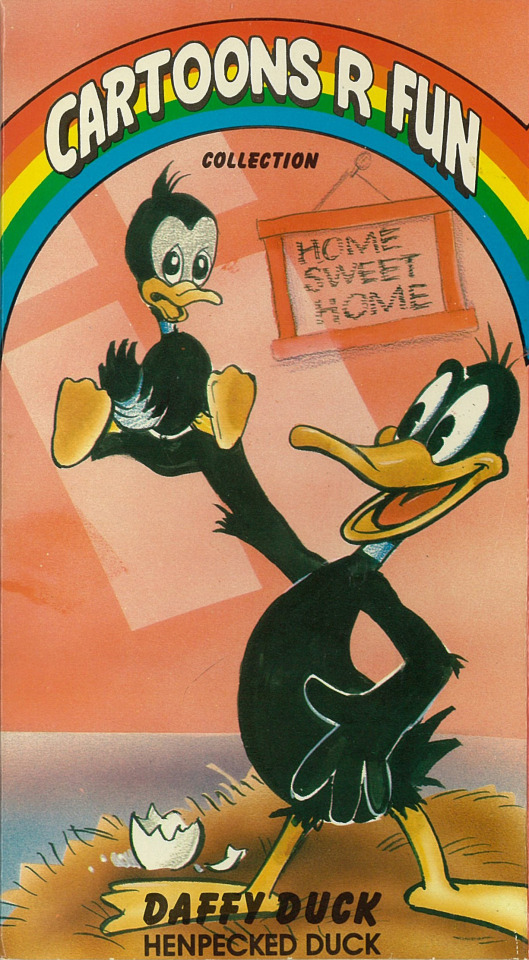
(image: vcrfromheck.tumblr.com)
What you see before you is a facsimile of a VHS tape my grandmother mysteriously owned in the early nineties. The tape was specifically for my older sister and myself in the hopes that it would pacify us if we got too rowdy. My grandmother eventually donated it once we were older....without asking my permission. We're not on speaking terms at the present moment.
The videotape was entitled "Cartoons R Fun", which is embossed on a rainbow you might see arched over Mount Ararat post-Deluge. Indeed, cartoons "r" fun, if you forgive the juvenile usage of a homophonic letter as a plural present tense of the verb "to be".
Daffy Duck, proudly standing on a tan blob with thin pencil lines to signify a nest (one that's peacefully floating on a violet overcast sky), is holding a freshly-hatched, over-sized duckling in his hand, as a quaint HOME SWEET HOME knick-knack looks on lovingly. Not an accurate depiction of the advertised short, but we'll cross that poorly-drawn bridge when we get to it. However, the tilted Dr. Caligari-esque shadow of a window in the background is indicative of the mood of the short in question.
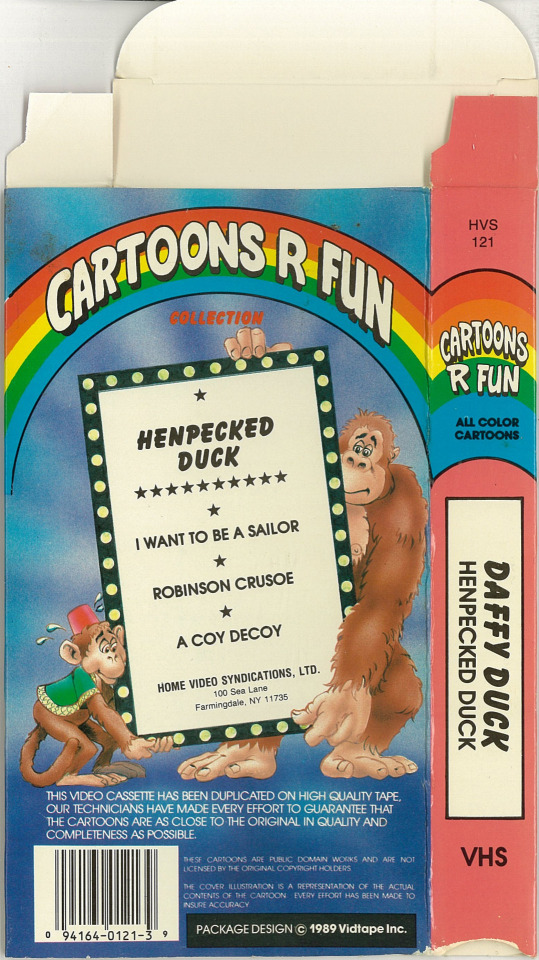
(image: vcrfromheck.tumblr.com)
The tape was top-loaded with four chortle-filled public domain follies produced between 1937 and 1941. Those amusements being, The Henpecked Duck, I Wanna Be a Sailor (see?), Robinson Crusoe Jr., and A Coy Decoy, as the tape advertises in a tacky brush font, on a showbiz marquee being lugged about by two (presumably) unpaid simian laborers, "Henpecked Duck and MANY MORE..." ("Henpecked Duck", as you might have noted, is missing a definite article, adding to the lackadaisical charm of the proceedings).
These tapes were not the best quality. I know this because the last ten seconds of A Coy Decoy are cut out, missing the all-important punchline of Daffy procreating with a toy duck. (it took me fifteen years to discover this, thanks to the miracle of www.youtube). The tape was too short so it ended on a blue screen of death. The shorts were not in black-and-white, nor are they in color, as the box cover deceptively advertises with its omnipresent "all color" rainbow. Rather, it's presented in a dusty sepia-tone (the shorts fell into public domain so I can incorrectly presume that the sepia is an after-effect of neglected film preservation). This in itself is not a bad thing. I like my cartoons to look like the first act of The Wizard of Oz. They look pristine and well-preserved, like something perfectly bronzed to a fine sheen. If I were to flick my finger, the film would make an audible 'ding'.
Anyway, the cartoon that sticks out the most (obviously, it's the main feature) is The Henpecked Duck. Released on August 30th, 1941 (about three months before the United States entered World War II....this was back when the epidemic of housewives battering their husbands with frying pans was of more pressing concern than Hitler), it was directed by Bob Clampett (the insane bad boy of the Warner Bros. animation department) and written by Warren Foster. It concerns a married Daffy Duck getting into some hot water after accidentally misplacing their unborn child. It is an intense piece of marital melodrama framed through the irreverent filter of Looney Tunes.
I've always been drawn to it. Not in any sort of substantive way (I'm not a child of divorce or anything of the sort), but in the sense that it's a piece of media that I've consumed to such a inordinate degree that it gains a kind of vague meaningfulness. It's also an overlooked short that I feel should have a little light drawn towards it, as a way of saving it from the gaping maw of obscurity. And since every piece of media has been discussed to death on the internet, I thought I could annoy you and place my minuscule stakes on this 7-minute short from 1941. Hopefully, this will be the final, definitive word on the subject. My legacy depends on it.
Let's examine this short in embarrassing, navel-gazing detail, shall we?. Not just gazing, mind you, I mean gripping my hairy belly between my two mitts and, depending on how much bendable flexibility I still have stored in my rapidly fading youthful figure, blow into my umbilicus scar, until you hear an audible plop-plop-plop.
(note: I put a sepia filter on these black & white screencaps to simulate how I experienced The Henpecked Duck as a child.)
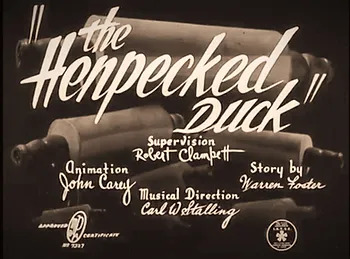
WAH WAH WAH WAH WAHHHHHHHHHH. Doodly-doo, doodly-doo, scattily woo woo woo woo doo, doodly-doo, doodly-doo, doo doo. (That was obviously Mendelssohn playing over those overlapping rolling pins.)
The short opens on darkness, a cacophony of plaintive whinging blooms on the soundtrack. People are demanding divorces left and right. The camera suddenly springs back from the darkness to reveal the shadowy entrance of what appears to be a ramshackle barn or chicken coop. It's hard to tell considering the entrance takes up the entire frame. The lack of a proper wide establishing shot and the numerous disembodied voices only adds to the feeling of anxious dislocation. A wooden plank leads forbiddingly into the darkness. A crudely written sign hangs over the entrance, "Court of Inhuman Relations."
(A small reservation I have is the sound mixing on the voices being too loud. You can almost hear Carl Stalling's score which, from the few strains that I'm able to eke out, carry an foreboding menace).
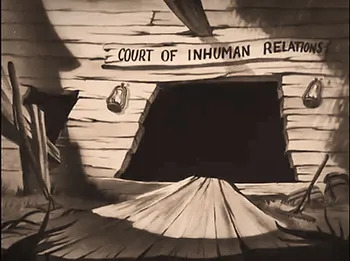
Transition to a close-up of Porky's gavel (Porky is presiding over this raucous kangaroo court) rapping on the judge's stand with an aggressiveness too intense for the viewer to even process in these first few seconds. The camera rapidly pulls back from the gavel, to a wider shot of Porky, to an extreme low-angle long shot of the aisle as the crowd quiets down. Already, we have two instances of the camera springing back rapidly from close-ups to establishing shots, as if the cameraman was suddenly dropped out of the sky and is quickly trying to adjust to the foreign scenario he has just encountered. Needless to say, it has a startling effect.

Porky Pig announces the first case of the day: Duck vs. Duck. He orders Mr. Daffy Duck to approach the stand. There is a shot from Porky's perspective where we can see the entire courtroom with Porky's gavel and water jug hugely prominent in the foreground (they take up almost half of the frame, symbolizing the firm grip that the rural judicial system has even over the lowliest waterfowl). The courtroom is a surreal scene indeed. It consists of barnyard animals, from a duck with an abnormally long neck, to a dopey-looking black mutt, to a fat hog sitting uncomfortably on one of the benches, and a snoring elderly hen (who provide a few visual gags near the end of the short).
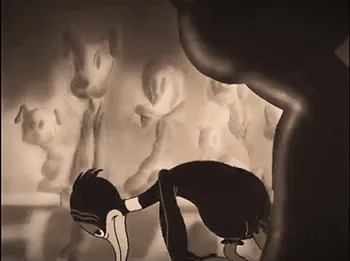
Daffy Duck slowly shuffles up the aisle. His overbearingly grim disposition are not unlike a POW during the Bataan Death March, with his slouched posture and hangdog eyes. Stalling's score is just as slow and methodical; a prominent trombone emitting a onomatopoeic 'wah-wah'. He walks past the onlooking crowd, eerily still and blurred in the background. The few figures he walks past in the foreground are featureless and emit a dull glow like bronze statues. The stillness of the crowd make Daffy's isolation unbearable.
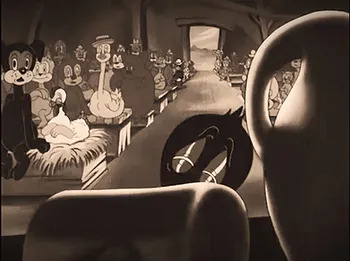
Daffy approaches the stand as Porky calls up Mrs. Daffy Duck. Before I move on, I must point out a glancing detail and a naggingly under discussed trope of old 30's-40's cartoons: glassy eyelids. Daffy blinks a few times as he looks up at Porky on the stand. His eyelids have a glassy, polished tint, as if run through a shoe buffer. It is an unsettling detail, adding to the surreality of the mise-en-scène.
Mrs. Duck, unlike Daffy, charges up the aisle with a straw boater cocked at an angle, in the manner of old-time gangsters, and a ridiculous poofy ball bouncing from it (what else could one call it but a 'poofy ball'?), giving off a unexpectedly violent energy. Unlike the pathetic trombone used on Daffy, Stalling utilizes blaring trumpets, giving her entrance a martial air. I must amusingly point out that Mrs. Duck is essentially Daffy with a hat and skirt (no pronounced Minnie Mouse eyelashes either).

Shot from an intense low angle close-up, Mrs. Duck, the perennial battle-ax stereotype, chants the four most iconic words of my salad years: "I WANT A DIVORCE! I WANT A DIVORCE!" It's amazing how a single moment can be so easily etched into such an impressionable young mind. The immediacy of it (no one in real life can shout banal declarations with such dramatic relish) and its startling bluntness struck me as unusual in a Looney Tunes short. It's so dramatically heightened when compared to the more relatively light-hearted tone of other Warner Bros shorts. Though as I've grown older, I can't help but see a bit of the parodic in it; melodrama bursting to the brink of burlesque. Not to mention the almost shrill string section that accompany these outbursts.
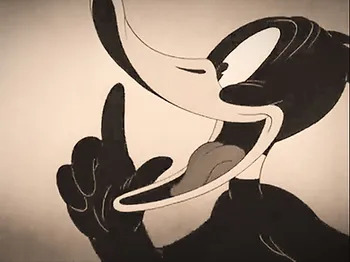
Mrs. Duck rains a flurry of invective on Daffy (with a couple of thwacks on the head from her vanity parasol). We get a closeup of Daffy, where we get some fine acting on his end. As she twaddles on, he winces and grimaces, being verbally battered into submission. At one point, she commands him to respond. In a subtle bit of comic acting, Daffy opens his beak in an air of sarcasm (noted by the over-exaggerated intake of breath), and just as he's about to speak, he automatically snaps his beak closed just as she tells him to shut up. Henpecked, indeed, if you are unironically tickled by the avian-adjacent pun of its title.
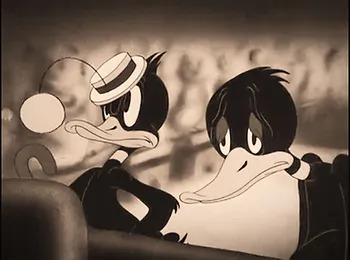
The Honorable Porky Pig orders Mrs. Duck to calm herself and explain the origins of this particular domestic strife. I must point out that as Porky speaks, we get a two-shot of Mr. and Mrs. Duck. It's almost a still shot, except for the poofy ball on her hat, which slowly bounces until it comes to a stop, like a toy soldier winding down. It's a minute detail that adds to her energetic characterization. Even when she's still, she's moving.
At this point we are launched into the dramatic thrust of the short. We are spirited backward into the past by way of flashback. This is where the real fun begins.
We arrive at the abode of the Ducks (we get no exterior establishing shot) where silhouettes (projected on a wall of two by fours, adding to the rural decrepitude) of the couple hover over a nest with a plump half-oval of an egg nestled on top. A framed embroidered artwork of the words "Home Sweet Home" adds a touch of ironic bonhomie (the music of "Home Sweet Home" is gently playing in the background). Mrs. Duck is lovingly instructing Daffy to manually incubate the egg while she goes to visit her mother. She walks past the camera and out of frame. She then violently (and comically) juts her face back into frame (her beak thrusting like a dagger) with an idle threat of strangulation (the music suddenly turns menacing).
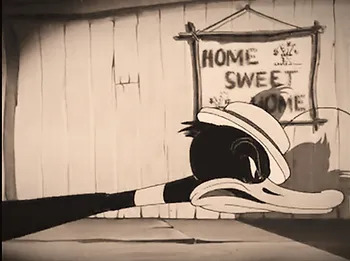
Daffy sits obediently on the nest, replying to every matrimonial trumpet blast with the soft-spoken yet seethingly sarcastic, "Yes, m'love." Daffy's comic acting is brilliant here. The frozen smile, the disingenuously coy eye-blinking, the listless, non-committal head nodding. Not to mention Carl Stalling's expressive soundtrack, with Mrs. Duck's dialogue highlighted by stormy percussion and Daffy's highlighted by softer staccato variations on the "Home Sweet Home" theme. When Mrs. Duck leaves, Daffy gets up off the nest and vents out his frustration, mocking her with multiple "Yes, m'love's" (we also get a sense of the wide space of their sparsely furnished house, giving it the feeling of a stage). The omniscient Mrs. Duck suddenly bursts through the door screaming, "What's that?!" Daffy springs back to the nest (the music oddly spring-like itself), a eerie moment of silence before Daffy quietly, obediently says, "Yes, m'love." Mrs. Duck leaves.
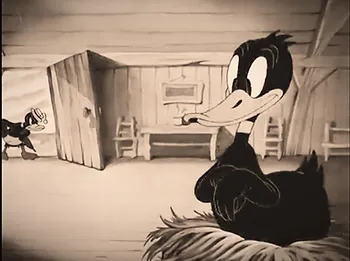
After an indeterminate passage of time, Daffy is still sitting on the egg (his arms uselessly crossed as opposed to the demure limpness he expressed when the missus was about), looking bored and restless. Carl Stalling's score here is particularly striking, giving this little interlude a weird note of foreboding. Daffy decides to examine the egg, shake it, and balance it precariously on his digit. How I relate to Daffy's fascination! There is something miraculous about that ovoid vessel. Its perfect shape and dimensions. Its firm yet fragile shell, its smell reminiscent of sticking your hand out of a speeding car window, then smelling the palm once retracted. When you put a knife to a boiled egg, you see its uniform circularity with its white outer layer and its yellow yolk (sans zygote, of course).
Daffy, in a fit of pure sponteneum, lays to rest the age-old chicken-or-the-egg conundrum by rendering it moot. We get an extreme close-up of his hand fondling the egg then pressing the egg between his palms until it is squeezed out of existence. Even Harry Handcuffs couldn't pull off a feat of such trickery. Daffy, standing confidently on his nest like a master sleight-of-hand, chants some magical hoodoo ("Hocus pocus, flippety flam, razzmatazz, and alacazam!") and the egg reappears between his two fingers (with an amusing "boing", clearly a human's voice).
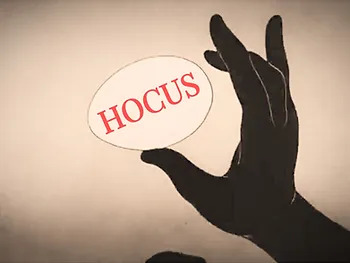
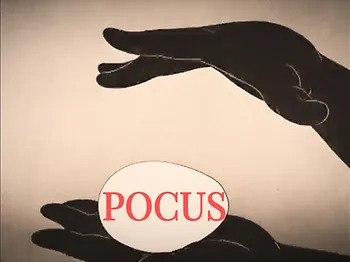

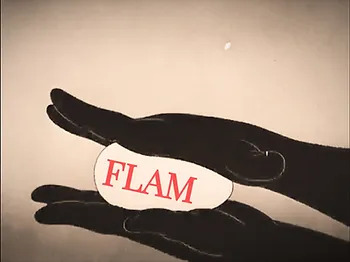
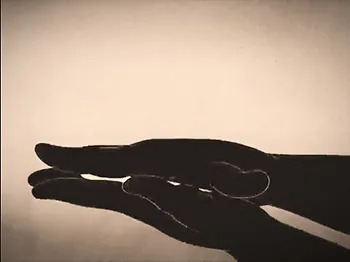
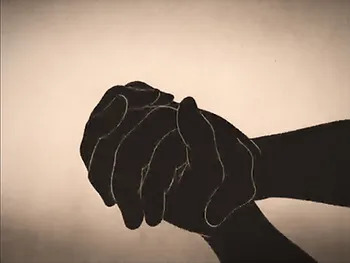

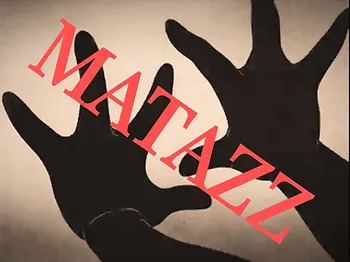
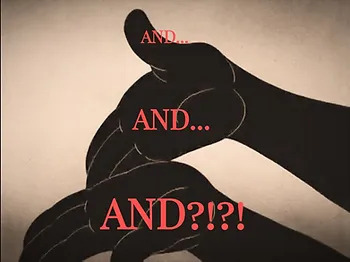


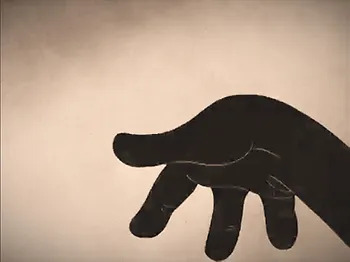
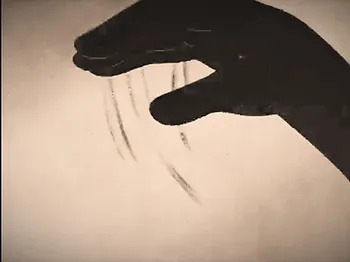
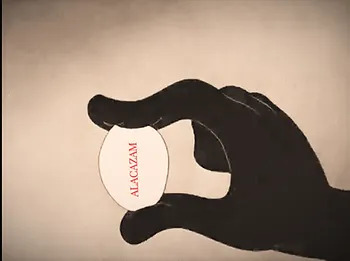
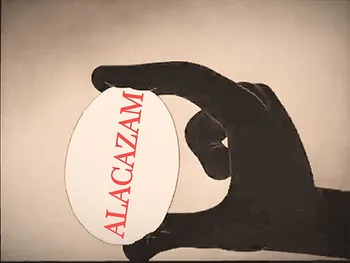
He is amazed by his newfound abilities and addresses the audience with cross-eyed relish. Notice that the borders of the frame move inward so there there is a thick black outline underneath and to the sides. We cut to a wide shot of Daffy stepping off his nest (making a hearty reference to Major Bowes, an old "Gong Show"-esque radio program) and then stepping forward and out of the frame, his feet planted on the black. It's meant to be a fourth-wall gag but it's awkwardly executed because you notice the frame retracting in preparation for the gag. Frankly, I'm not quite sure why they had to break the fourth wall at that particular moment.

Daffy makes the egg disappear again. I must point out Stalling's lovely rendition of Juventino Rosas' waltz, "Sobre las Olas" (Over the Waves), a calming Wurlitzer standard, but like its title, suggests that Daffy is heading into choppy waters. He repeats the magic words and, lo and behold, the egg does not reappear. Daffy's eyes bulge out of his head and looks at the audience, shrugging with uneasy reassurance. He tries again. Same result. The tempo of the scene steadily grows faster (along with the score) as Daffy desperately tries to make the egg reappear. Daffy is now hysterically banging the floor, imploring an indifferent deity to make his unborn child whole again. Of course, it wouldn't be Looney Tunes if they didn't make Daffy break the fourth wall ("Say, is there a magician in the house?"), then immediately falling back into character (now that felt like a more appropriate fourth-wall gag than the previous one). A clock ticks on unrepentantly.
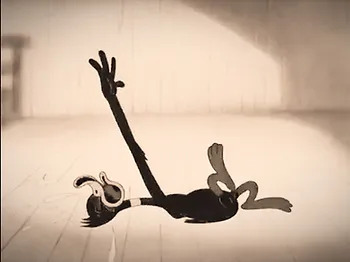
(continued in Part 2...I hoped to fool you and claim it's Part 1 as a dramatic cliffhanger for this intense marital thriller...it's only because Tumblr allows 30 images per post so I had to break it up into two parts....I apologize if I have completely demystified this [allegedly] mature and thoughtful examination)
5 notes
·
View notes
Text

A vengeance-minded Margarete Schön in the title role of Fritz Lang's 1924 dark fantasy epic DIE NIBELUNGEN: KRIEMHILD'S REVENGE ("Die Nibelungen: Kriemhilds Rache"). . Lang protested the idea that his Die Nibelungen work in the 1920s in any way presaged, paved the way for, or "was a premonition of" the ascendancy of Nazism in the early 1930s, an idea put forward in Siegfried Kracauer’s book From Caligari to Hitler: A Psychological History of the German Film. . "By making ‘Die Nibelungen,’" Lang said in a 1974 interview, "I wanted to show that Germany was searching for an ideal in her past, even during the horrible time after World War I in which the film was made. At that time in Berlin I remember seeing a poster on the street, which pictured a woman dancing with a skeleton. The caption read: ‘Berlin, you are dancing with Death.’ To counteract this pessimistic spirit I wanted to film the epic legend of Siegfried so that Germany could draw inspiration from her past, and not, as Mr. Kracauer's book suggests, as a looking forward to the rise of a political figure like Hitler or some such stupid thing as that." (Silent and Pre-Code Horror)
1 note
·
View note
Text
Sara Reads an Infuriating Book, part 2
Chapter 2 of W Scott Poole's Wasteland is entitled "Waxworks". This is where I got angry enough to start taking notes in earnest rather than just annotating the ebook, so this is longer and has more actual quotes.
First, a disclaimer: I do not in any way disbelieve that WWI had a huge impact on early 20th century horror. Of course it did; how could it not? What I object to is Poole's assertion that it is the only thing that could possibly have had such an impact and that that impact always and only comes in the form of fear of bodily death and the corpse as an object of horror. Any time anyone gives you a Grand Unified Theory of Horror that claims to explain all of reasons that humans create scary or disturbing art, that theory is never going to be correct. People are more complex than that. And now, bullet points!
Okay, first off, I do have to apologize for ranting about Poole talking about Machen's "The Bowmen" without actually talking about it last chapter, because he talks about the story explicitly in this chapter. This is a structural thing he does repeatedly: he'll mention a writer/director/etc and hint at a work he's going to discuss later without actually naming it. (In this chapter, he does this with Fritz Lang and Metropolis.) This structural choice is not well-signposted and I don't care for it, but at least now I know that's what he's doing.
He also touches on Lovecraft again here, so I apologize as well for accusing him of skipping ol' Howie. Here, we talk briefly about "Herbert West: Re-animator", as it's the only Lovecraft story to a) actually feature WWI explicitly and b) deal much with corpses. There's also this quote about Cthulhu which is...a big fucking stretch: "He raised great Cthulhu, a monster that has haunted the century, a new death’s head spreading wide his black wings of apocalypse, which was clearly recognizable as the Great War and its meaning continued to menace the world."
Like, there is absolutely an argument to be made that WWI was a major influence on the invention of cosmic horror at the beginning of the 20th century. Again, how could it not be? WWI was proof for a lot of people that the universe fundamentally didn't care about them. But that's the thing that I don't think Poole gets - cosmic horror is not about the fear that you are going to die. Cosmic horror doesn't care about your corpse because it doesn't care about you. Cosmic horror is about the fear that no one cares that you exist at all. That is a huge and important difference.
As the chapter title implies, there is a lot of repeated discussion this chapter of waxworks, dolls, puppets, poppets, etc. Poole insists over and over again that a) all of these simulacra can be collapsed symbolically into a single image and that image is of a corpse and b) these objects became horrific after WWI because of the corpse thing. But then he'll go through the history of the fascination with creepy wax figures stretching back to wax images of saints through Madame Tussaud's Chamber of Horrors, or he'll talk about dolls and reference E T A Hoffman's The Sandman (from 1817), which, to my mind, totally undercuts his point. You don't need the Great War to make waxworks creepy, my dude.
(Somewhat relatedly - there is a really interesting book to be written about the prevalence of hypnotism/mind control/sleepwalking in early horror film, but it is not going to be this book because Poole thinks all that's happening there is more corpses.)
Which leads us to the discussion of The Cabinet of Caligari! Poole spends a lot of time rehashing a widely accepted interpretation of the film proposed by Siegfried Kracauer in his 1947 book From Caligari to Hitler: Kracauer reads the film as a warning about the dangers of authoritarianism, with the somnambulist Cesare standing in for the people of Europe who unconsciously do the evil bidding of their authoritarian masters. Not saying that's the only possible reading of the film - I don't believe there's only one possible reading of any film - but it's an interesting and persuasive one. 'Nope!' says Poole. See, his theory is that the filmmakers wanted to get artist Alfred Kubin to design the look of the film (he did not end up working on the film), Kubin's work has a lot of doll-like figures in it, dolls are always corpses, and therefore Caligari is, once again, only about how all those people died in the war. This is the only thing the filmmakers could have meant.
(On the positive side, this did lead me to look up the art of Alfred Kubin, which I was previously unfamiliar with. It's pretty rad.)
"There’s not enough evidence, for example, that the world understood that their somnambulistic obedience helped produce the outrages of the Great War." I don't see that the world as a whole has to see that in order for the film to attempt to convey that meaning - surely what matters is that the filmmaker saw it and made a film about it. It's not necessary for the world to understand the meaning behind a work of art for a person to make that work of art.
(Somewhat ironically, Poole complains that Kracauer is only capable of interpreting German film in the 1920s through the lens of his pet theory. Who does that remind me of? Couldn't say.)
Oh my god this is already so long, I haven't even talked about J'accuse. Poole thinks J'accuse is a zombie movie which I won't argue because I've only read about it and haven't seen it yet - that could be a valid interpretation for all I know. But then he compares it unfavorably to Romero zombie films and complains that the director of J'accuse "did not really know what to do with [his zombies]", just because they rise from their graves, make their point, and then return to their graves. The entire point of the film is to make the viewer bear witness to the dead. Poole even says this: "The film’s theme of marital infidelity, that inescapable trope in the cinema of the Great War, became a symbol for the larger question of whether the nation had been faithful to the cause of its soldiers. The dead came back to make sure they had." What else did you want the zombies to do???
God, the whole section about Vampyr made me crazy. Poole is all, "Carl Theodore Dreyer had little connection to the war and I’m not going to show any actual evidence that the war had an impact on his work but he made Vampyr in 1932 and it’s weird and scary and full of shadows and creepy imagery, so obviously it’s about WWI." (nb not at all an actual quote.) There's just no acknowledgement that a person might make a horror film that was inspired by something that happened to them that wasn't WWI. Hell, there's no acknowledgement that a person might make a horror film because they like making spooky stuff. I was a monster kid basically from birth - I suffered no trauma to make me that way. I certainly didn't participate in WWI. Explain that, W Scott Poole.
Lastly, he's just factually wrong about The Phantom of the Opera, in that he claims that the 1925 film presents no explanation for Erik's deformity, unlike the novel. This is not correct - there is no reason for his deformity in the novel either. Later films added that. The lack of explanation in the 1925 film is not a response to mutilated war veterans; it's just an accurate adaptation. Poole says, "No one in the Western world could have looked at the visage of Lon Chaney and not thought of what the French called the gueules cassées…" and maybe that's true, but he's just stating a theory based on a mistake and presenting no evidence.
On the plus side, I'm making a very cool list of books I want to read from the works cited, and also some films that I haven't gotten around to seeing yet.
#i left out the bit where he talks for several paragraphs about the first italian horror film: 'il mostro di frankenstein'#before revealing that this is a completely lost film#to the point that what remains of it is some promotional materials a photo one still and a single contemporary review#but he's sure that it supports his thesis#and also the bit where i'm sad every day that i don't have a time machine that would allow me to attend performances at the grand guignol#sara reads an infuriating book
2 notes
·
View notes
Text
The Tragedy of the Maimed Goddess
It is estimated that around half of all movies made prior to the year 1950 are gone forever. As soon as I learned about this statistic, it never left my mind. So many hours of work, so much artistic vision, lost to time. As mortals, we age and die, it is our lot in life, but we always hope to leave something of ourselves behind when we finally pass on. To know that one’s work may simply disappear is of the utmost horror to me; it robs us of our only chance for some kind of immortality.
It gets worse when you look at silent films, of which only an estimated 25% currently remain. Until very recently, I had assumed that The Tragedy of the Maimed Goddess was one such lost film.
The Tragedy of the Maimed Goddess is a 1937 horror film, made long after silent pictures had been relegated to ancient history. Keep in mind, this was over a decade since Nosferatu and The Cabinet of Dr. Caligari first debuted, and the long shadows cast by Dracula, The Mummy, and Frankenstein firmly cemented the fact that talkies were the future of horror. However, The Tragedy’s director, Karl Falkner, was firmly convinced that silent films still had a place in the world.
Falkner was an open homosexual, crossdresser, and communist, a man infamous for flouting societal norms. Some of his earlier films have survived, either wholly or in partial form. The films that have withstood the test of time were mainly simple dramas or comedies, more interesting for their director rather than the actual content itself. The most memorable of Falkner’s earlier work are those featuring his then-lover, Dietrich Bauer.
Falkner was a rather small, effeminate gentleman, with a soft face and messy brown hair. In contrast, Bauer was a hulking giant of a man, over 6 feet tall with a strong jaw and a shock of light blond hair. In a handful of books relating to German films during the interwar period, one can find a photo of Falkner and Bauer side by side, both smiling for the camera. They enjoyed a modestly successful career throughout the mid 20s till the early 30s, but times soon changed.
During the time of the Weimar Republic, Falkner’s eccentricities were seen as interesting and exotic, but when the iron fist of fascism commenced to tighten its grip on public sentiment, such behavior was increasingly viewed as signs of degeneracy. Falkner fled for America in 1933 following the appointment of Adolf Hitler as chancellor of Germany. Rumor has it that Falkner begged his lover to leave with him, but that Bauer refused, choosing instead to change his name and continue his career as an actor. Allegedly, Bauer’s final acting credits were in a handful of Nazi propaganda films under a pseudonym, though the exact specifics are unknown. Dietrich Bauer’s strong-jawed, blue-eyed face is so stereotypical of the Nazi ideal that it is difficult to distinguish him from the scores of other actors in such films.
In any event, when Karl Falkner arrived in the United States in 1933, he found himself an unwanted stranger in an unfriendly land. The Great Depression was in full swing, and as a result work was rather difficult to find for the German expatriate. For 4 years Falkner lived frugally, his slender figure becoming skeletal in appearance, and his brown hair turning gray from stress.
Finally, in the spring of 1937, Falkner had saved up enough money to begin work on what was meant to be his magnum opus. Years of backbreaking work, living on scraps, the expense of his entire life savings, and, supposedly, involvement with organized crime culminated in the creation of The Tragedy of the Maimed Goddess.
Despite silent movies having been long deemed obsolete since the emergence of talkies, Falkner insisted that the movie feature no dialogue or sound effects, only a musical score played by a live orchestra. The production was written, produced, and directed entirely by Falkner, with every detail painstakingly arranged to perfectly fit his vision. Filming only took a matter of weeks, and only a month later, the film was ready for its first screening to a group of representatives from various film distributors.
There were no other screenings.
Every single member of the audience walked out of the theater in disgust before the film even reached the halfway mark. Marcus Finnegan, a representative of United Artists, described The Tragedy as “the most awful thing I’d ever seen. I have no idea how that kraut idiot thought it would get past the Hays code. Good God! I wouldn’t dare sit through it even for a million dollars!”
Shortly afterwards, Karl Falkner vanished without a trace, along with the only copy of The Tragedy of the Maimed Goddess. The popular view is that Falker had accrued a significant amount of debt with the mafia, and that he was quietly murdered after his film failed to turn a profit. The only surviving piece of media relating to The Tragedy is the original sheet music for the orchestra, which was covered as a concept album by the short-lived band Robert's Chamber in the late 90s.
Moving forward to the present day, let me tell you how I came to see Falkner’s supposedly lost masterpiece.
My name is Fran. I work at an independent movie theater in Southern California, lets call it the Cinepalace. It's nothing special, just a single screen with enough space to seat maybe 100 people at the most, but it's enough to make a meager profit off of popcorn sales and midnight showings of cult classics.
The owner of the Cinepalace is a middle aged gentleman named Alan. He purchased the theater in the early 2000s after the previous owners settled down to retire. I am his only employee. Alan handles the ticket counter, finances, and popcorn sales, leaving me to work the projection booth.
As I said, most of the films we show are far from blockbusters. The Rocky Horror Picture Show, Plan 9 from Outer Space, and Pink Flamingos have graced the Cinepalace's screen on multiple occasions. Aside from the midnight movies, during daylight hours we often show old Westerns and Dramas to attract an older audience.
As you've probably already guessed, the Cinepalace is rather old to say the least. The floorboards creak, the paint is peeling, and you can get a discount on popcorn for showing proof of a squished cockroach. Alan has tossed around ideas of refurbishment before, but both of us know it's just a pipe dream.
About a week ago, an earthquake hit our little town. It's not necessarily an uncommon occurrence in California, but it did succeed in adding an air of excitement to our screening of El Dorado. After the rather literal dust had settled and the old-timers had left the theater, Alan pulled me aside and pointed out an uncomfortably obvious crack in the drywall, perhaps 5 inches in width at the largest point.
"Jesus Christ, look at this. You see the crap I have to deal with? It's a wonder this decrepit wreck of a theater doesn't just fall apart at the seams. I'm going to run down to my house to get some stuff to fix this mess, I'll be back in an hour or so. In the meantime you try and see how bad the damage is and get everything closed up for the night" he said, hitching up his jeans as he began to head out of the building.
I wished him luck and turned back to the crack, pulling out a small flashlight from my coat pocket to peer around inside. I noticed a faint glint of something metallic reflecting the shine of my flashlight, and I carefully reached inside the crack to see what it could be.
My eyes widened as I pulled out the film reel, encased in its metal canister. I blew off nearly a century's worth of dust from the object, revealing a label, written roughly in marker: "The Tragedy of the Maimed Goddess Reel 1".
I was visibly shaking with excitement as I sat down in the folding chair by the popcorn machine, re-reading the label over and over, trying to convince myself I wasn't dreaming. This film had been a personal fascination of mine ever since I first stumbled across its existence while I was studying for a film degree. I wrote a paper on it, theorizing on what it may have been about. I never expected that I would ever be able to actually hold what may have been the only copy.
Carefully removing the lid, I looked inside. The 35mm film looked to be in perfect condition, despite its age. Giddy with excitement, I closed the canister once again and peered back into the crack with my flashlight, looking for more. Rummaging about for a bit, I found 4 more reels, each similarly labeled to the first. Combined with the first reel, that came out to around 50 minutes of film.
Completely ignoring my assigned task of searching for further damage, I raced to the projection booth with my prize, immediately clicking them into place into one of the smaller projectors and setting up a portable projection screen. We'd often run new films we got like that first, rather than trying them out on the big screen.
"Something is missing", I muttered to myself, before realizing what else I needed. Pulling out my phone, I quickly pulled up the album The Tragedy of the Maimed Goddess by Robert's Chamber before connecting it to a portable speaker.
With everything set, I started the projector and began playing the album simultaneously. To my surprise, no credits played, the film simply began abruptly.
The droning soundtrack blared over the cheap speaker as the projector showed an image of the moon, floating in an inky, starless night. The moon faded into a human eye, the camera zooming out to show its owner, a woman in a pale robe, the tiara atop Her head adorned with a stylized crescent moon. She sat atop a throne of antlers. I knew at once She was the titular Goddess.
The shot changed, showing a group of almost nude women dancing about the Goddess's throne. They seemed to be in a forest clearing, surrounded by trees on all sides. A bonfire and the full moon above provided ample illumination with which to see by. Dancing amongst the women was a tall, dark figure, clad in black robes. At first I thought he was wearing some sort of headdress, before I realized he had the head of a goat. The sound of drums and mad fluting filled my ears from the recorded soundtrack.
After many shots of the goat-headed man and revelers, another group of barely clothed women carried forth a young man, wrapped in primitive ropes and gagged with cloth. His eyes were filled with stark terror. One of the women drew forth a jagged flint knife from her belt, driving it into the man's neck.
As the Goddess watched, emotionless, dozens more of the dancing women all drew forth similar weapons and descended upon the young man, plunging mercilessly into his exposed flesh. Blood spewed forth from his wounds, covering all nearby with a shower of gore. The flutes and drumming increased in their frantic intensity.
A man, dressed in hunter's clothes, was shown cowering in fear in the bushes nearby, his eyes wide with the horror of all he has seen. The man was old, with scars on his face, as if he had been attacked by a wild animal in the distant past. He carefully slipped away, heading back into the forest. The camera followed the man, the flutes and drums fading into silence as he moved further from the clearing. The soundtrack occasionally played a soft piping sound, mimicking the hooting of owls. The strings of violins were plucked gently, creating an unnerving sound as the hunter crept through the darkened woods.
The whole time as the hunter fled into the woods, there was an air of tension, a sense that he, and by extension, the audience, was being watched. He would occasionally hide behind a tree, evidently trying to slow his breathing, and sometimes one could almost make out something lurking in the shadows, only for it to fade away moments later.
Finally, the hunter arrived at a village, whereupon he began knocking on the doors of every house, the staccato rap of his hand on wood imitated by the drums of the soundtrack. His face showed clear signs of speech, but there was no dialogue, no title cards appeared to show what the hunter was saying. As he continued knocking on doors, the villagers began to awaken from their slumber and leave their homes, with clarinets, trumpets, trombones, and other instruments adding to the score to indicate their commotion. Once a large enough crowd had gathered, the hunter stood atop a crate in the center of the village, and began speaking to the gathered crowd. Once again, there was no title card to indicate what he was saying, but the fury and terror on his face spoke for him. The camera panned over the crowd, and showed the growing fear and rage on their faces. They began to shout, the music becoming louder and growing into an almost militaristic fervor.
The hunter hopped down and began leading the villagers into the woods. As they marched forth, the villagers began to arm themselves with torches, knives, pitchforks, and other makeshift weapons. The camera followed them on their long trek through the forest, but gone was the furtive and unnerving plucking of violins. The villagers made no attempt to hide, to skulk in the shadows; they were out for vengeance.
The camera cut back to the clearing, where the dancing women and the goat-headed man continued their cavorting about the taciturn Goddess's throne. The only sign of their victim that remained was a pile of bones, picked clean of flesh and organs. The discordant drums and squealing flutes of their revelry were cut off by a violent crash of cymbals and the blare of trumpets as the villagers charged into the clearing, the hunter in the lead.
The worshipers were cut down by the dozen, each death punctuated by the crash of a cymbal. The goat-headed man tried to flee, but one of his horns was lopped off with a cleaver in the process, blood spewing from the wound as he stumbled off into the dark woods.
The Goddess's face turned from a stern, solemn expression to one of horror as Her followers were killed. She got up from Her throne of antlers, crescent moon tiara glinting in the light of the bonfire. However, as soon as She moved to leave, She was grabbed by the mob, Her screaming simulated by the discordant wailing of a violin.
With the dancers all either dead or fleeing, the mob turned their ire to the Goddess. A crude cross had been constructed out of wooden planks, and they swiftly tied Her to it with hempen rope. The hunter approached, wielding a makeshift spear. He put out the Goddess's eyes with the weapon, each strike punctuated with the shrieking of the violin. The music became very quiet as the camera zoomed in towards the Goddess's face, clearly showing Her bloodied eye sockets. The moon was directly above Her head. It went out.
The soundtrack began blasting horrible sounds; the screeching of string instruments, blaring of the brass, and the discordant piping of woodwinds. But, despite the cacophony, there was nothing on the screen. I paused the album and looked over at the projector, trying to see if something was wrong.
I was shocked to realize I had already gone through all 5 film reels, somehow changing them out while I watched. I was apparently so enthralled by the film that I had done it automatically, not even realizing.
I checked my phone to see how much of the album was left. There was another 10 minutes. The entire soundtrack was an hour in length, meaning that there must be a reel missing. I quickly put the reels back in their canisters and hid them among the other movies.
I ran back downstairs to the crack in the wall, frantically searching for the last reel. I had to see the whole film. I couldn't explain why, but it called to me somehow. I reached deep into the crack with my arm up to the shoulder, feeling around in the shadows, but there was nothing. I was about to pull my arm out and grab a sledgehammer to widen the gap, when something grabbed me by the wrist. I shrieked in terror and tried to pull back, but it gripped tighter, and tighter.
The door to the theater opened with the jingle of the bell and I fell backwards, sobbing, as whatever had grabbed me released its terrible grip.
"Whoa, Fran, hey, what's going on? Are you alright?" asked Alan, concern in his voice.
I tried to compose myself. "Um, yeah, yes, I'm fine. Sorry, there was, uh, a spider", I lied. I didn't know why I lied, it's not like he wouldn't have believed me. Alan trusted me, and he wouldn't have called me crazy if I told him what was going on. But something inside me wouldn't let me tell him.
"I have to go, sorry, I'm not feeling well", I muttered, before Alan could even respond to what I said. Not processing his sputtering protestations, I quickly walked out the door, rubbing my wrist with my free hand.
I didn't own a car, but I lived only a few blocks away. It was around 3 AM, and the night was dark, even more so than usual. Looking overhead, I could see no stars in the sky, just the shining crescent moon. It was strange, usually one could get a great view of the night sky around here.
Alan probably won't find the reels, I thought to myself, after all, he has little reason to do a thorough search of the projection booth unless he is doing inventory. I stopped walking for a moment, processing what I just thought. Why wouldn't I want Alan to see the film? I had hidden them almost on instinct, like it was the most natural thing in the world, but surely I wouldn't want to hide this find from him. Did I want fame? Fortune? The more I thought about it, the more I didn't understand my hesitancy. It felt almost like the possessiveness of a jealous lover.
Movement caught my eye, stopping my train of thought. Something was in the alleyway near me. I heard a hacking cough from within. Almost as though I were a puppet on strings, I felt myself stepping towards the sound.
I reached the mouth of the alleyway and drew forth my flashlight, shining it towards the coughing. I saw a man in ragged clothes, barely covered with a cheap blanket. Once my light touched him, he raised his head, staring at me.
It was the hunter from The Tragedy of the Maimed Goddess. Every detail, from his wrinkled skin, to the graying hair. Even the scars, carved into his face by some unknown beast.
I dropped my flashlight for a moment, so startled was I to see the man. I fumbled for it for a few seconds, before once again pointing the light at the man's face.
"Hey! Can't you see I'm trying to get some damn sleep!" cried out the homeless man whose eyes I was shining my flashlight into. His face had changed. He was younger now, without scars, a different hair color. He couldn't have been the same man I'd seen just a second before.
I muttered an apology and tossed some dollar bills on the ground at the alley's entrance. I continued the walk back to my apartment, a little faster than I had been going before. I looked back up at the sky, and the stars were back to normal, clear as could be.
I slept fitfully that night, tossing and turning. My dreams were vague, difficult to fully remember, yet disturbing nonetheless. I remember a sense of terror, a fear that I was being pursued. I was outside, in the dead of night, surrounded by trees on all sides. Occasionally I could hear the plucking of violins. I tripped over a root underfoot, and I knew that I was doomed.
Then I was awake, lying in bed. My phone chimed, informing me I had received a text. I looked over my notifications, seeing a number of messages from Alan, asking where I was. I checked the time, seeing that it was several hours past when I was supposed to have awoken. I shot him a text saying that I wasn't feeling well, that I was feverish, and then turned off my phone.
I needed to get some groceries, so I got dressed and headed out the door, walking a few blocks down to the grocery store. I wasn't fully paying attention to my surroundings. My mind kept thinking back to the homeless man in the alley, my dreams, and most of all The Tragedy. Lost in my thoughts, I simply grabbed the items on my list and headed for the check stand, not even processing the greeting of the cashier.
As I fumbled for my wallet, I looked up to apologize for my inattentiveness, whereupon I was greeted with a horrible sight.
The cashier's face was that of the Goddess, Her eyeless sockets boring into my very soul. Her face was contorted in a hideous grimace of agony, and I shrieked in terror, backing away quickly. I slipped and fell, landing on my backside. Looking up, I saw the cashier's face was simply that of an ordinary woman, a bit shocked at my outburst.
I mumbled out an apology, saying something about losing my balance, and quickly paid for my groceries before leaving in a hurry. As I walked down the crowded street back towards my apartment, I noticed that the hustle and bustle of conversation, cars, and movement all around me sounded more like the tuning of an orchestra than the day-to-day clamor of a busy street.
I could hear the sounds of clarinets, violins, trumpets, and even an organ, all mixing together to form something that sounded almost but not quite like a crowd. I looked around, and could see no source for such a din. I covered my ears as best as I could while still holding my groceries, and pressed forward through the crowd.
As soon as I reached my apartment building, I practically ran for the safety of my home. However, as I groped around for my keys, I noticed an envelope in front of my door, closed with a wax seal bearing the symbol of a crescent moon. I knew, deep down in my gut, that I needed to read it.
Setting down my bags, I broke open the seal and pulled out the note within. The paper seemed old, like the pages of a well-read book. Scratchy handwriting spelled out the words; It is time to finish what you've started. Meet me as soon as you can. Herzlicht, K.F. Below the message was an address, located somewhere in Los Angeles, near Hollywood.
I detected movement out of the corner of my eye, and looked quickly to see a black-robed figure turning a corner. Somehow I knew they must be the deliverer of the message. I ran over to see who it was, calling for them to stop, but as I rounded the corner, there was nobody there.
Later that evening, I purchased a train ticket for a trip to LA. I went to bed early to catch the bus to the station, and was once again subjected to a fitful, restless sleep.
I dreamt that I danced around a great bonfire, surrounded by an ancient forest. I shrieked with laughter as I circled the blazing fire, but no sounds left my lips, instead my ears were filled with the sound of drums and flutes. I was among friends, others who danced alongside me, fellow worshipers of the Goddess of the woods.
Suddenly, I felt a horrible, stabbing pain in my back, and I turned to see the vengeful glare of one of the village folk, his knife plunged deep between my ribs. I fell to the grass-covered ground, eyes open, as I looked upon the form of my Goddess sitting atop her throne of antlers.
I woke to the sound of my phone's alarm going off, reminding me that I needed to get to the bus in time to catch my train. I ate breakfast quickly, before throwing some clothes on and heading out the door. The bus ride was relatively short, and soon I found myself on a 4 hour train ride to the city of angels.
As I sat in my seat, looking out across the scenery, my mind was filled with countless questions. Am I crazy? Why am I obeying the letter's instruction? Who sent me the letter?
I hardly noticed when we arrived at our destination, and it took me a moment to snap out of my stupor and make my way on to the platform. Pulling out my phone, I opened up the navigation app and typed in the address indicated on the note.
Once again, the sound of the crowd was replaced with the cacophonous sounds of an orchestra tuning their instruments. There were no voices, just the sound of discordant music mimicking human speech. I kept my head down and tried to focus on my phone, though my nerves were beginning to fray.
I was instructed to turn down an alleyway by my phone, and soon found myself in a far less occupied part of town. I followed a path through what felt like a maze of tunnels, the sky a tiny patch of blue surrounded by brick and mortar. It went on far longer than it felt like it should, a labyrinth of fire escapes, trash cans, and back doors. It felt like hours, but whenever I checked my phone, it claimed only a few minutes had passed.
I could have swore I sometimes heard the distant plucking of a violin, or noticed a vague form dashing around a corner, but such moments passed so quickly it was difficult to know whether or not my mind was simply playing tricks upon me.
Finally, I found myself at my destination. It was a rundown apartment building, with a boarded up door bearing a sign labeled "CONDEMNED". I double checked the note, check to see if I went to the correct address, but there was no error.
I searched for a method of entrance, before spying a bit of graffiti above one of the boarded ground floor windows. It was a crescent moon, spray painted in a sickly yellow, with an arrow pointing downwards. Looking closer at the window, I noticed how loose the boards were, and I made quick work of prying them off and tossing them out of the way. Turning on my flashlight, I pulled myself through the opening and stepped inside.
The interior of the building was extremely dark, and smelled strongly of decay. I could faintly hear the sound of a piano playing from deeper within the building, and followed the sound as best as I could. Graffiti covered the walls, full of the usual suspects; swastikas, tags, profanity, etc. Yet as I continued deeper into the building, more and more often I began to notice the spray painted symbol of a crescent moon. It felt like it was following me, watching me as if it were an eye. The eye of the Goddess.
Eventually, the music became clear enough for me to distinguish that the tune was Debussy's Claire de Lune. A minute or two later, I reached the door from which the music seemed to be emanating from. It seemed to just be the entrance to an ordinary apartment. I hesitated for a moment, considering where I was, what I was doing. Maybe it would be best to try and see a doctor I thought to myself. But then I thought about the note folded in my pants pocket, and steeled myself. I opened the door.
Despite all natural laws of physics, the room beyond was far larger than it possibly could have been based on the exterior dimensions. It was a vast ballroom, beautiful, but in disrepair. Despite the daylight outside, the shattered windows showed a black, starless night. A crescent moon hung low in the sky, seeming to grin at me. There was no form of artificial illumination, yet I could see fairly clearly.
I wasn't alone in the ballroom. Two figures danced slowly to the haunting melody of Claire de Lune, which I could now tell was emitting from an antique phonograph. One was short, perhaps 5'6" or so, while the other stood well over 6 feet. The shorter figure was clad in a beautiful white ballgown, with messy gray hair, while the tall individual they danced with seemed to be wearing some sort of black suit.
It was only when I noticed the red armband on the left arm that I realized what he was wearing. It was the coal black uniform of an SS officer. The song came to an end, and the ballgown-clad figure separated from their fascist dance partner, walking calmly towards me.
I gasped as I realized who I was looking at. My mind flashed to the photograph of Karl Falkner I had seen in a few books on interwar German cinema, and compared the image to the man who now stood before me. His hair was gray from stress and age, his face slightly more lined, but it was definitely Falkner. I realized that the taller man in the black uniform must be Dietrich Bauer.
"You received my message, I take it?" asked the director, smiling faintly. The faintest hint of a German accent tinged his words.
I couldn't respond. I was standing before a man who should have died decades ago. Yet, as I looked upon him, he couldn't have been more than 50 years old. I just sat and stared, my mouth open.
"Tch, close your mouth child, you'll catch flies" said Falkner, before snapping his slender fingers. At once, the hulking form of Dietrich Bauer appeared, carrying two folding chairs, which he promptly unfolded and set down on the polished wooden floor. Up close, I could see that he had no eyes, his uniform stained with dried blood and vitreous fluid. The expression on the Nazi's face was blank, mindless. Whatever personality Bauer once possessed had long since been replaced with robotic obedience.
Falkner sat down on one of the chairs, motioning for me to take the other. I did so, still silent from shock.
"So, what did you think of my film?" asked Falkner, folding his hands on his lap. His red painted nails contrasted with the white of the ballgown. I tried to shake myself out of my confusion.
"Your film?" I asked.
"The Tragedy of the Maimed Goddess. Don't try to play dumb with me, I know you've seen it. You wouldn't be here otherwise."
I thought for a moment, genuinely unsure how to respond. Falkner sat patiently as I organized my thoughts. Finally, I spoke. "It was very... strange. The use of the orchestra not merely as soundtrack but as a substitute for dialogue, the lack of title cards, and the pagan symbolism, those elements gave the film an almost a dream-like quality. Like something out of a fairy tale perhaps. I wish I could have seen the ending."
Falkner gave a wry smile. "Aside from Dietrich and myself, nobody has ever seen The Tragedy's ending. Those idiot businessmen left the moment of the sacrifice scene. Stomachs were a tad less strong back then. Perhaps, for the sake of the world, that is a good thing."
I swallowed, looking over at Bauer's black-clad form standing behind Falkner. His eyeless face remained entirely expressionless.
"Don't expect him to say anything", said Falkner, his smile seeming to falter somewhat, "what is left of Dietrich may be an excellent dance partner, but as a conversationalist he is woefully lacking. Don't worry, he's perfectly harmless. My collaborators made sure of that." "Your collaborators?" He sighed, crossing his legs and holding out his hand, snapping his fingers again. Bauer silently produced a cigarette, ignited it with a silver lighter, and handed it to Falkner. He took a long drag before responding. "Yes. They're the ones who approached me with the idea for the film in the first place."
My head spun. The impossibility of what was happening was beginning to fray my nerves, but I tried to remain focused. "I thought you came up with the idea yourself? From what I've read, you worked almost entirely alone, aside from the actors. " "Well, my collaborators weren't exactly the sort who get much in the way of publicity", he leaned closer, his voice quieting, "they came to me in my dreams." There was a trace of simultaneous fear and reverence in his voice.
"Who are they?" "Oh now that's a very difficult question, very hard to explain. Tell me, have you ever been alone? Truly, entirely alone? When there is not so much as an insect buzzing to keep you company?"
I nodded.
"Now, seeing as you are entirely alone, and fully cognizant of your loneliness, have you ever felt like something was watching you? Have you checked corners, ceilings, even under beds, just to alleviate that nagging, itching feeling of being observed? They are the reason."
The hairs on the back of my neck stood on end, and I suddenly felt incredibly exposed. I glanced around the vast ballroom, seeing nothing but shadows aside from Falkner and his companion. I wondered what might be hiding in those shadows. Becoming increasingly paranoid, I got up out of my seat, beginning to pace about the ballroom to steady my nerves. "Why is any of this happening? It's just a movie! This isn't real." "Just a movie? When the grim shadow of Count Orlok stretches his clawed fingers across the screen, do you not shiver with fear? When Chaplin's Little Tramp gets himself into some absurd situation, do you not laugh with delight? Stories affect us, child, since the earliest days of troglodytic proto-humans cowering around a campfire, drawing on the cave walls with charcoal. The Tragedy of the Maimed Goddess is no different, just somewhat more powerful, particularly the final reel. Some people can handle it, like myself, others..." Falkner trailed off, his gaze looking towards Dietrich's blank, eyeless stare.
"What is this place? Why are you here? Where is the final reel?" I asked the director, becoming increasingly aware of how bizarre my situation was, desperate for answers.
Falkner smiled sadly. "This place is my home now. My collaborators took me here after I finished the film. Time works differently here, as I'm sure you can tell. As for the final reel, I had it sent to Berlin following the disastrous first showing. I knew my time in the regular world was going to come to an end, so I sent it to the one person on Earth who I felt I would be able to spend eternity with. I was horrified to find what Dietrich had become in the intervening years, when They dragged him here in that horrible uniform, eyes gouged out and mind shattered."
In the far distance, I heard the sound of an orchestra beginning to tune their instruments. Falkner's sad smile fell away, replaced with horror, and he stood up from his chair. "Listen to me," he hissed, as if trying to yell and whisper at the same time, "it's too late for me, but you still have a chance. They want you to see the final reel, to share it with the world. I'm certain that They have already taken it to your home. But you have a choice, you don't have to do that."
He handed me a pistol. I've never been particularly interested in firearms, but even I can recognize a Luger when I see one. I looked over at the eyeless, silent form of Dietrich Bauer, noticing the empty holster at his side. "What am I supposed to do with this?" I asked, fearfully. The distant orchestra grew louder.
"End your life on your own terms, before it is too late. You've seen enough so far that they'll never leave you alone, the hallucinations will only get worse until you either go mad or do as they demand. Death is better than an eternity here!"
I was about to protest, when Falkner shushed me and looked over his shoulder into the gloom. I followed his gaze, but saw nothing. "Run!" he screamed, turning back around and pushing me towards the exit "They're coming!"
I stumbled backwards, steadying myself. I saw the crescent moon overhead, slowly waxing into a solid white circle, as though it were an all-seeing eye, watching me. I didn't need to be told twice, I ran for the exit. The orchestra swelled in intensity, till it felt as though my eardrums would burst. When I finally crossed the threshold of the ballroom, I slammed the door behind me, and suddenly all was silent.
I sat and caught my breath for a few moments, looking at the peeling paint of the old door. Part of me wondered if I opened it again, would I find that ballroom once more? Or would it just be a moldy old apartment? I decided not to risk it, and hurried my way outside, hiding the pistol in my backpack.
I caught the train home just in time, and tried to ignore the eyeless, bloodied stare of the Goddess's face on the ticket taker. I pretended I couldn't see the film grain that stained the sky as the sun slowly set, a crescent moon shining down upon me like a sardonic smile. I tried not to hear the sound of the orchestra replacing the chatter of the train's occupants.
When I finally arrived back home to my apartment, I found the final film reel laying on my bed, along with a projector already set up and pointed at my wall. The message was clear.
I've typed up this narrative because I have a decision to make. I have the pistol lying on my desk, and the film reel set up in the projector. From what Falkner tells me, if I watch the final 10 minutes of the film, I will join him and Dietrich forever in that unnatural, otherworldly ballroom. If I don't, I will be driven to madness until I seek out the sweet relief of a bullet to the head. Neither are particularly appealing. So I pose the question to you all; what do I choose?
4 notes
·
View notes
Text
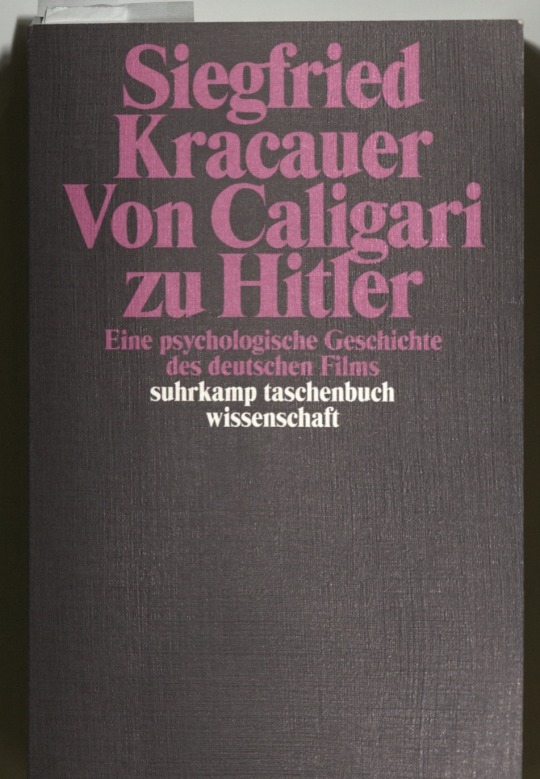







varieté, ewald andré dupont 1925 (playlist, piano music)
#from caligari to hitler#a psychological history of the german film#siegfried kracauer#princeton university press#1947#ruth baumgarten#karsten witte#suhrkamp#1979#vorstellung#geste#nation#mentalität#frieden und krieg#la noblesse du mendeant#varieté#ewald andré dupont#emil jannings#für uns#feuertaufe#sieg im westen#paris#besatzung#wochenschau#francofonia#der zerbrochene krug#28#books
1 note
·
View note
Text
With the term ‘degenerate art’, the Nazis labelled all art forms that, in their view, stood in opposition or obstacle to the purification of German culture.
What did not comply with the stereotypic representation of beauty and did not convey the values of militarism, racial purity, and heroism was forbidden, resulting in the banning of subjective, unconventional, and non-figurative art; basically everything that was irrational or remotely interpretable – from the Cubists’ fragmentation of reality to Fauves’ unrealistic colours and the pioneering examples of abstract art.
Since the National Socialists aspired to war, the depiction of the horrors of war by artists of the Weimar Republic that had suffered the brutality of World War I, like Otto Dix, and Ernst Ludwig Kirchner, were unacceptable. War scenes could only suggest courage, masculinity, and heroism.
From Nolde, Heckel, and Kirchner to Matisse, Picasso, and Van Gogh but also Klee, Archipenko, Chagall, Kandinsky. All forms of modernism were covered – from Impressionism to New Objectivity – and juxtaposed, with complete disdain, with works by patients of mental institutions.
The background
In the first decades of the 20th century, Germany was one of the major hubs of modern art in Europe. Following the early radical experience of Die Brücke and Der Blaue Reiter, under the Weimar government of the 1920s, the country saw a further renaissance that affected the cultural scenery in all its aspects. A new approach to design flourished at Bauhaus, jazz bands and cabaret became popular, and Expressionism extended from painting and sculpture to architecture, literature, theatre, dance, and cinema with masterpieces such as The Cabinet of Dr. Caligari by Robert Wiene (1920) and Nosferatu by Murnau (1922). However, this cultural golden age did not last long. The socio-economic instability resulting from the onset of the Great Depression in the United States laid the groundwork for the Nazi party to nurture and meet a growing consensus. When Adolf Hitler was appointed chancellor in January 1933, drastic change was visited upon all aspects of German society.
The Nazi government considered the Weimar mores – mostly of American influence – as obscene and antithetical to traditional German values, making the Weimar culture, along with avant-gardism art in all its aspects, a threat in terms of both formal and intellectual expression. In September 1933, Joseph Goebbels, the Reich Minister for Public Enlightenment and Propaganda, was put in charge of the Reich Culture Chamber, whose members – all ‘racially pure’ Party supporters – were the only ones “allowed to be productive in our cultural life”. The assault on modernism was manifested in numerous systematic cleansing actions. Artists and musicians were discharged from teaching positions; museum directors that displayed modern art were dismissed; books were burnt; music, films and plays censored; thousands of artworks confiscated from public collections. The majority were destroyed, while others, those considered ‘marketable’, sold abroad to raise funds for the regime. This extensive purge targeted what the Nazis deemed Entartete Kunst – ‘degenerate art’.
Degenerate Art
With the term ‘degenerate art’, the Nazis labelled all art forms that, in their view, stood in opposition or obstacle to the purification of German culture. Inevitably associated with liberal democracy, they perceived modernism as a sign of cultural decline as well as a deliberate attack against German people. Entartete were those works that “insult German feeling, or destroy or confuse natural form or simply reveal an absence of adequate manual and artistic skill”.


Degeneracy was, however, a fluid notion and its definitions were not always so clear, if not even contradictory. For example, Felix Nussbaum, German-Jewish surrealist painter and victim of the Holocaust, was not in the blacklist, while the work of Emil Nolde, anti-Semite, and determined Nazi supporter, was deemed degenerate with over one thousands works confiscated from German institutions. Ultimately, the final arbiter and judge was Hitler and his personal taste.
The show


In the first three rooms, artworks were categorised thematically; blasphemous pieces, art by Jewish or Communist artists, art offensive to the German people. The rest had no specific theme. Insulting and derisive slogans ran across the walls; texts like “Nature, as seen by sick minds”, “madness becomes method” or “revelation of the Jewish racial soul”. Intentionally, the organisation was curatorial chaos. Works were amassed incoherently in overcrowded spaces. They were often unframed, incorrectly attributed, and labelled; also accompanied by quotations from artists reported wrong or out of context.
Today, apart from a few photographs, there remains silent footage shot by American cinematographer Julien Bryan, who later stated: “People might not believe my story if I told it in words when I returned to America. Everyone would believe my pictures”.
1937 Munich Exhibition of Degenerate Art
The legacy of the ‘Degenerate Art’ show
The exhibition lasted four months and then went on to tour the country. In Munich alone, it attracted more than two million visitors, an average of 20,000 people per day, making it the most popular modern art show of all time.
0 notes
Text
“It wasn’t that I was expecting these movies to provide a step-by-step guide for fending off fascism, but I think I was looking for a lens to make the present a little more comprehensible. That lens turned out to be surprisingly literal, and it was attached to an antique Stachow-Filmer camera.”
Bonus for mention of Kracauer's From Caligari to Hitler, which held me spellbound and sent me on a Weimar-era-movie jag.
0 notes
Text
“Obviously the double is nothing more than a projection of one of the two souls inhabiting Baldwin. The greedy self that makes him succumb to devilish temptations assumes a life of its own and sets out to destroy the other and better self he has betrayed. At the end the desperate student shoots his reflection in the same attic from which he once emerged. The shot fired at the apparition kills only himself.”
— Siegfried Kracauer, From Caligari to Hitler: A Psychological History of the German Film
19 notes
·
View notes
Photo

Seen in 2020:
From Caligari to Hitler: German Cinema in the Age of the Masses (Rudiger Suchland), 2014
#films#movies#stills#docs#documentary#Rudiger Suchland#From Caligari to Hitler#German Cinema in the Age of the Masses#Weimar Cinema#Expressionism#Doctor Mabuse#Fritz Lang#Rudolf Klein-Rogge#German#2010s#Mubi#seen in 2020
1 note
·
View note
Photo

(vía Weimar: From Caligari to Hitler)
Rudolf Dischinger, Bedrohung (Menace), 1935
13 notes
·
View notes
Text
this week i read a 300 page book in two days and topped my own record with it, because the last time i read a book in two days was when i was 8 and the book was Emil und die Detektive for a book report
#Petra speaks#this time it was the book titled From Caligari To Hitler so#and it did mention Emil und die Detektive because apparently it's been adapted into a movie
5 notes
·
View notes